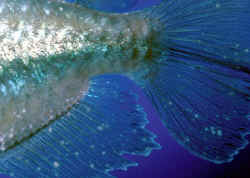Hey I've written out all these common fish diseases. If I've missed any please add to this topic. 

Ich/White Spot: This is probably one of the most common fish diseases. Ich looks like literally white spots all over the fish. This is a Protozoan disease caused by Ichthyophthirius in fresh water aqauriums (Cryptocarion irritans in Marine). It is a parasite that attacks the eyes, fins, gills, skin and mouth interior.
Symptoms: White spots all over the fish. The fish may attempt to scrape itself against objects in the aquarium, have a loss of appetite or a stressed-rapid breathing. The parasite can only be affected by treatment during the free-swimming stages of the cycle.
Treatment : A Copper Sulfate or Copper Formalin medicine should be able to kill most infections. There are many medicines all do the trick. If the fish are salt tolerant give your fish a salt bath. Also raise the temp this ups the life cycle of the disgusting parasite.
If the fish are salt tolerant give your fish a salt bath. Also raise the temp this ups the life cycle of the disgusting parasite.
Velvet Similar to ich except the white spots appear 'dusty'.
Symptoms Same as ich except dusty spots
Treatment Same as ich
Dropsy : One of the most disturbing of fish diseases, and is rarely cureable. Dropsy is an internal bacterial infection.
and is rarely cureable. Dropsy is an internal bacterial infection.
Symptoms: The fish's scales will stand out, making it have a pine comb look. Sometimes eyes can .blow up'.
Treatment : Use Kanamycin or Tetracycline and raise the temperature to about 80 degrees/ 30 deg C. This helps remove the fluid note this is rarly curablee.
Fungus:: Common disease that effects all kinds tropical fish. Fungus mostly infects in poor water conditions in which there are unacceptable levels of ammonia or nitrites. Fin nippers will damage the fins of other fish making them more susceptible to fungal infections and external bacterial infections such as fin and tail rot.
Symptoms A white cottony fluff will appear on fish. Can be around body or in mouth. Fin rot appears as white on ends of fins.
Treatment: Relatively easy. Add appropriate medication (Available for all fungal infections). If fish are salt tolerant add salt. Raise the temp to 30 deg C or 80deg F.
Swimbladder: This is a disease that effects the fishes swim bladder.
Symptoms: Fish swim side-ways or rest on bottom and can't go to surface.
Treatment: Raise the temperature, add appropriate medication for swim bladder. Note this is a disease that is rarely curable.
Cysts This is a uncommon disease. Fish infected by systs should be ethunaised before the cyst bursts.
Symptoms: Large balls appear on fish internally or externally. They look full of fluid and are relatively large.
Ich/White Spot: This is probably one of the most common fish diseases. Ich looks like literally white spots all over the fish. This is a Protozoan disease caused by Ichthyophthirius in fresh water aqauriums (Cryptocarion irritans in Marine). It is a parasite that attacks the eyes, fins, gills, skin and mouth interior.
Symptoms: White spots all over the fish. The fish may attempt to scrape itself against objects in the aquarium, have a loss of appetite or a stressed-rapid breathing. The parasite can only be affected by treatment during the free-swimming stages of the cycle.
Treatment : A Copper Sulfate or Copper Formalin medicine should be able to kill most infections. There are many medicines all do the trick.
Velvet Similar to ich except the white spots appear 'dusty'.
Symptoms Same as ich except dusty spots
Treatment Same as ich
Dropsy : One of the most disturbing of fish diseases,
Symptoms: The fish's scales will stand out, making it have a pine comb look. Sometimes eyes can .blow up'.
Treatment : Use Kanamycin or Tetracycline and raise the temperature to about 80 degrees/ 30 deg C. This helps remove the fluid note this is rarly curablee.
Fungus:: Common disease that effects all kinds tropical fish. Fungus mostly infects in poor water conditions in which there are unacceptable levels of ammonia or nitrites. Fin nippers will damage the fins of other fish making them more susceptible to fungal infections and external bacterial infections such as fin and tail rot.
Symptoms A white cottony fluff will appear on fish. Can be around body or in mouth. Fin rot appears as white on ends of fins.
Treatment: Relatively easy. Add appropriate medication (Available for all fungal infections). If fish are salt tolerant add salt. Raise the temp to 30 deg C or 80deg F.
Swimbladder: This is a disease that effects the fishes swim bladder.
Symptoms: Fish swim side-ways or rest on bottom and can't go to surface.
Treatment: Raise the temperature, add appropriate medication for swim bladder. Note this is a disease that is rarely curable.
Cysts This is a uncommon disease. Fish infected by systs should be ethunaised before the cyst bursts.
Symptoms: Large balls appear on fish internally or externally. They look full of fluid and are relatively large.











 /www.research.ku.edu/explore/v2n2/im...ages/fish_2.jpg
/www.research.ku.edu/explore/v2n2/im...ages/fish_2.jpg